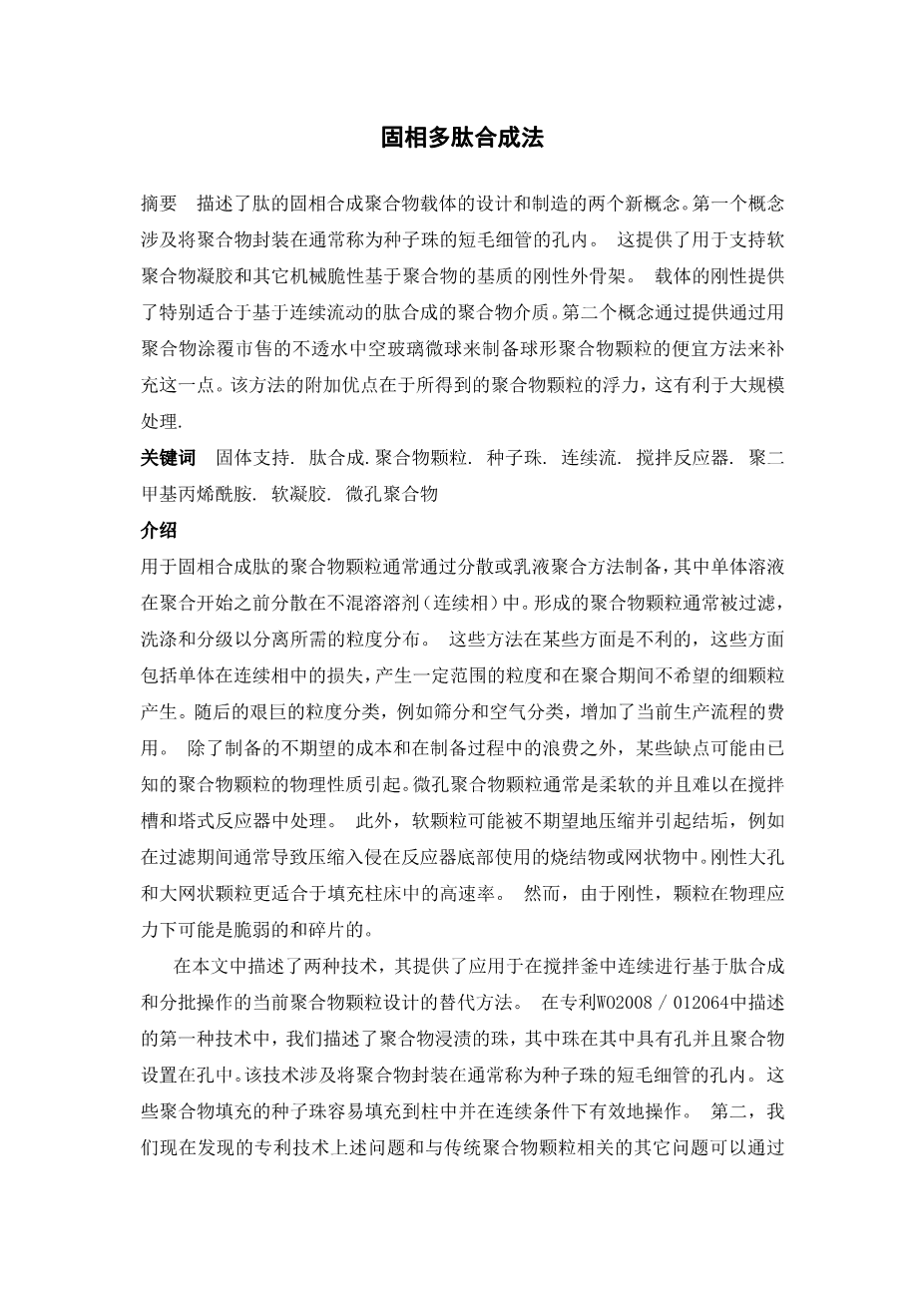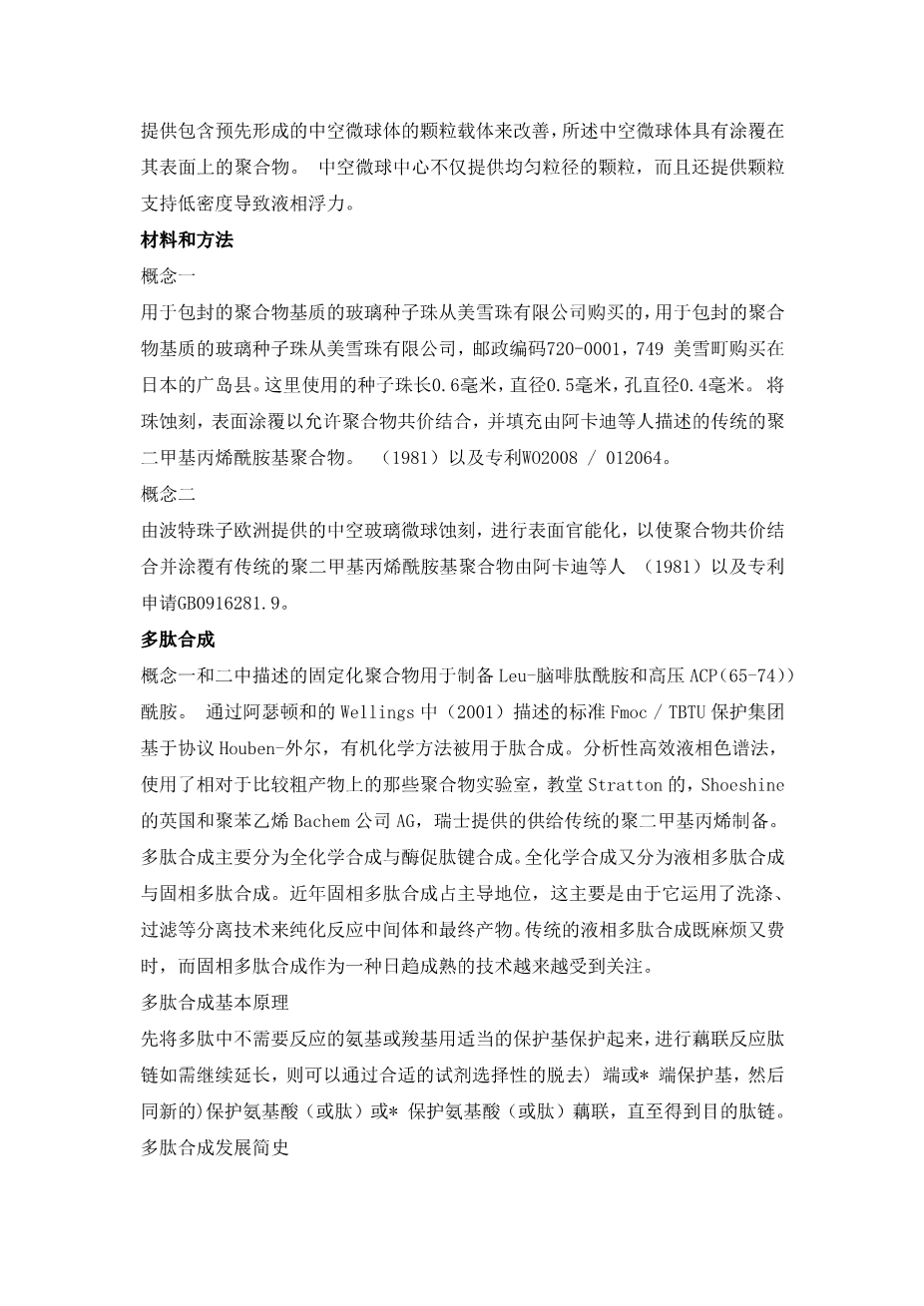Novel Concepts for the Design and Manufacture of Solid Supports for Synthesis of Peptides
Abstract Two novel concepts for the design and manufacture of polymer supports for solid phase synthesis of peptides are described. The first concept involves the encapsulation of polymers within the hole of short pieces of capillary tubing often referred to as seed beads. This provides a rigid exo-skeleton for the support of soft polymer gel and other mechanically fragile polymer based matrices. The rigidity of the support provides a polymeric media that is particularly suited to continuous fiow based peptide synthesis. The second concept complements this by providing an inexpensive approach to the preparation of spherical polymer particles by coating commercially available impervious hollow glass microspheres with polymer. The added advantage of this approach lies in the buoyancy of the resultant polymer particles, which facilitates handling on a large scale
Keywords Solid supports. Peptide synthesis .Polymer particles . Seed beads. Continuous flow . Stirred reactor . Polydimethylacrylamide . Soft gels . Microporous polymers
Introduction
Polymeric particles used in the solid phase synthesis of peptides are typically be made by a dispersion or emulsion polymerization process in which a solution of monomers is dispersed in an immiscible solvent (continuous phase) prior to initiation of the polymerization. The polymer particles formed are typically then filtered, washed and classified to isolate the required particle size distribution. These processes are disadvantageous in some respects which includes monomer loss to the continuous phase, generation of a range of particle sizes and the undesirable generation of fine particles during the polymerization.
The subsequent laborious particle size classi- fication, for example sieving and air classification adds to the expense of the current manufacturing processes. In addition to undesirable costs of manufacture and wastage during preparation certain disadvantages may arise with the physical properties of the known polymeric particles. Microporous polymeric particles are generally soft and difficult to handle in both stirred tanks and column based reactors. In addition, the soft particles may be compressed undesirably and cause fouling, for example, during filtration often leading to compressive intrusion into the sinter or mesh being used at the bottom of the reactor. Rigid macroporous and macroreticular particles are more suited to high fiow rates in packed column beds. However, due to the rigid nature the particles may be fragile and fragment under physical stress.
Two technologies are described in this paper which provides alternative approaches to the current polymer particle design applied to continuous fiow based peptide synthesis and batch-wise operations in stirred tanks. In the first technology, described in patent WO2008/012064, we describe a polymer-impregnated bead wherein the bead has a hole in it
and the polymer is disposed in the hole. This technology involves the encapsulation of polymers within the hole of short pieces of capillary tubing often referred to as seed beads. These polymer filled seed beads are readily packed into columns and operate efficiently under continuous fiow conditions. In the second, patented technology we have now found
that the problems described above and other problems associated with traditional polymer particles may be ameliorated by providing a particulate support comprising a preformed hollow microsphere having a polymer coated on its surface. The hollow microsphere centre not only provides a uniformly sized particle but also provides a particulate
support of a low density resulting in buoyancy in a liquid phase.
Materials and Methods
Concept 1
The glass seed beads used to encapsulate polymer matrices were purchased from Miyuki Beads Co Ltd, The glass seed beads used to encapsulate polymer matrices were purchased from Miyuki Beads Co Ltd, Zip-Code 720-0001, 749 Kamiiwanari, Miyuki-Cho, Fukuyama-Shi, Hiroshima-Pref., Japan. The seed beads used here were 0.6 mm length with a diameter of 0.5 mm and hole diameter of 0.4 mm. The beads were etched, surface coated to allow covalent binding of the polymer and filled with the traditional polydimethylacrylamide based polymer described by Arshady et al. (1981) and also in patent WO2008/012064.
Concept 2
Hollow glass microspheres supplied by Potters Beads Europe were etched, surface functionalized to allow covalent binding of the polymer and coated with the traditional polydimethylacrylamide based polymer described
by Arshady et al. (1981) and also in patent application GB0916281.9.
Peptide Synthesis
The immobilized polymers described in Concepts 1 and 2 were used to prepare Leu-enkephalin amide and ACP (65–74) amide. Standard Fmoc/TBTU based protocols described by Atherton and Wellings in (2001) Houben- Weyl, Methods of Organic Chemistry were used for peptide synthesis. Analytical HPLC was used to compare the crude products in relation to those prepared on traditional polydimethylacrylamide supplied by Polymer Laboratories, Church Stretton, Shropshire UK and polystyrene supplied by Bachem AG, Switzerland
Results and Discussion
The concepts described in this paper are complementary yet inextricably linked in that the key starting constructs for each technology are commercially available at very large scale with an extremely low cost.
The new technology described for continuous fiow based synthesis of peptides allows for the immobilization of extremely soft polymer gels that could not otherwise be used for peptide synthesis. Hydrophilic, highly solvated polymers with low levels of cross linking will facilitate the
synthesis
剩余内容已隐藏,支付完成后下载完整资料


英语译文共 6 页,剩余内容已隐藏,支付完成后下载完整资料
资料编号:[486249],资料为PDF文档或Word文档,PDF文档可免费转换为Word
以上是毕业论文外文翻译,课题毕业论文、任务书、文献综述、开题报告、程序设计、图纸设计等资料可联系客服协助查找。
您可能感兴趣的文章
- 通过对奥美拉唑合成反应的监测和定量反应的在线拉曼光谱和表征组件外文翻译资料
- 无金属碳基催化剂的研究进展外文翻译资料
- 钼酸钙/碳三维复合材料可控设计合成的研究外文翻译资料
- 生物催化选择性合成功能化喹唑啉酮衍生物外文翻译资料
- 三元V Zr Al ON氧氮化物-3-甲基吡啶氨氧化的高效催化剂外文翻译资料
- 综述纳米零价铁(nZVI)的合成,特性和在环境修复中的应用外文翻译资料
- 自消毒PVC表面使用点击化学设计外文翻译资料
- 微波辅助直接合成4H-1,2,4-苯并噻二嗪1,1-二氧化物衍生品外文翻译资料
- 微波辅助下直接合成1,1-二氧代-4H-1,2,4-苯并噻二嗪类衍生物外文翻译资料
- 压力选择在变压精馏中的重要性外文翻译资料


